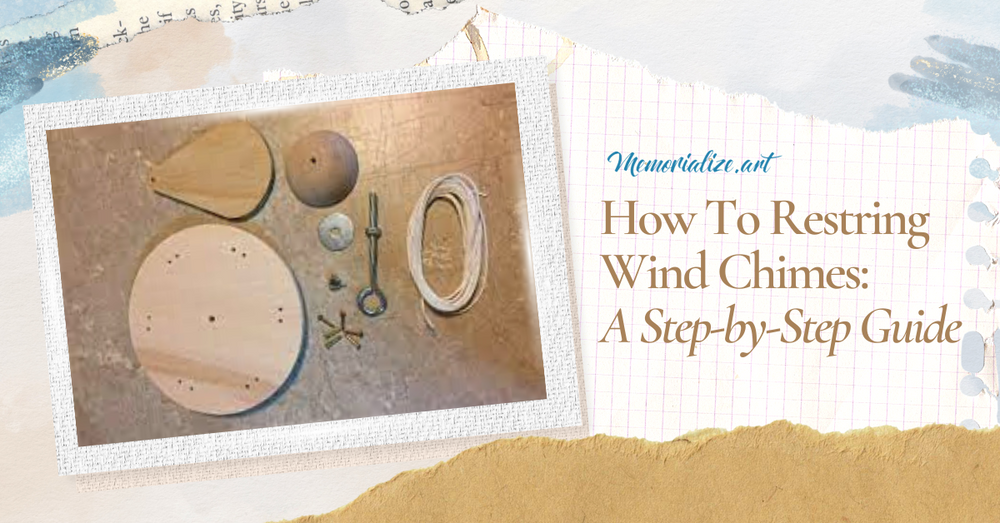How To Restring Wind Chimes: A Step-by-Step Guide

Wind chimes provide a symphony of melodies that dance with the breeze, but over time, wear and tear can mute their magic. If you've ever faced the silent stillness of your favorite chime due to a snapped or worn-out string, fret not. Learning how to restring a wind chime can breathe life back into its melodies, ensuring it continues to enchant for years to come. In this guide, we'll walk you through a step-by-step process to restore your wind chime to its former glory.

Photo by Nihongraphy from Pexels
Step-by-Step Guide to Restringing Your Wind Chimes
Wind chimes are a delightful addition to any home, creating ambient melodies that resonate with the natural ebb and flow of the environment. However, over time, the strings that hold these chimes can wear out. When that happens, it's essential to know how to restring them correctly to ensure they continue to produce their enchanting sounds. Here's a comprehensive breakdown of the process:
Gather Your Materials
Before you begin the restringing process, it's vital to have all the necessary materials at hand. Opt for a nylon cord or fishing line as they are durable and can withstand various weather conditions. Pair this with a sharp pair of scissors for cutting and a ruler or measuring tape to determine the right length. If you choose a nylon cord, a lighter can be handy to seal the ends and prevent fraying.
Remove Old String
The old, worn-out strings need to be removed to make way for the new. Carefully cut away the damaged cords, ensuring you don't inadvertently damage the chimes. It's a good practice to observe how the original strings were tied; this can provide valuable insight when it's time to string it back.
Measure and Cut the New Cord
Once the old strings are out of the way, measure the required length for the new cords. It's wise to cut the cord a few inches more than you think you need to account for the knots and any adjustments. This extra length can be trimmed off later, if necessary.
Start Restringing
With the new cord ready, begin the restringing process. Start at the top and work your way down, threading the cord through the holes dedicated for this purpose. If your chime design is intricate with multiple sections, always begin from the bottom tier and work your way up. Remember to tie secure knots, ensuring the chimes stay in place and are evenly spaced.
Ensure Evenness
An essential aspect of restringing is ensuring the chimes are evenly spaced and hang at the correct height. This spacing is critical for the chime to produce its harmonious sound. Adjust as necessary to achieve the desired melody.
Attach the Clapper and Sail
The clapper and sail are pivotal components of a wind chime. The clapper strikes the chimes to produce sound, while the sail catches the wind to move the clapper. Ensure both elements are correctly centered and hang appropriately for the best sound output.
Alternative Options for Repairing Wind Chimes
While restringing is the most common method of repair, there are alternative approaches to restoring or even enhancing your wind chimes. Here are some inventive and handy solutions:
Metal Wire Use
For those with metal chimes, consider using a thin, flexible metal wire instead of nylon cord. The durability of metal wire ensures longevity, especially for heavier chimes. Just ensure the wire isn't too thick, or it might dampen the sound.
Bead Reinforcement
If the holes in your chimes have expanded due to wear, causing strings to slip through, consider adding decorative beads as stoppers. They'll serve a dual purpose - holding the chime in place and adding an aesthetic touch.
Clapper Replacement
Sometimes, the issue isn't with the strings but the clapper. If it's worn out or damaged, consider replacing it with materials you have on hand. Objects like wooden beads, small metal discs, or even a piece of driftwood can serve as unique clappers.
Wind Sail Alternatives
If the wind sail—the piece catching the wind to activate the chime—gets damaged, you can get creative with replacements. Consider using a piece of leather, a feather, or even shaped wood as an alternative. The material and size of the sail can influence the frequency at which the chime rings.
Strengthen with Sealants
To increase the lifespan of your newly repaired chime, consider applying sealants. For metal chimes, a rust-resistant spray can be beneficial. For wooden elements, a weatherproof sealant can protect against the elements.
Comparison of Wind Chime Restringing Techniques
When it comes to restringing wind chimes, several techniques stand out, each with its own merits and demerits. Traditional nylon cords, for instance, are favored for their durability against the elements and flexibility, allowing chimes to sway freely. However, their susceptibility to wear and UV damage means periodic replacement. On the other hand, metal wires offer longevity, especially for heavier chimes, but might compromise the chime's tonal quality if too thick. Flexible plastic lines, like fishing lines, are not only weather-resistant but also visually discreet, letting the chimes shine without visible strings. Yet, they can sometimes stretch or become brittle over time.
The choice of technique ultimately depends on the chime's material, desired aesthetics, and sound quality, as well as the environment in which it's hung. Evaluating these factors ensures the chosen restringing method enhances both the chime's longevity and melodic charm.
Protecting Wind Chimes From String Damage
Protecting the strings of wind chimes is crucial for maintaining their melodious harmony over the years. While the chimes themselves are often made of sturdy materials like metal or wood, the strings can be more vulnerable to wear and tear. Environmental factors such as direct sunlight, rain, and strong winds can contribute to string damage. Using UV-resistant nylon cords can help in preventing premature degradation caused by sunlight. Applying a thin coat of a protective sealant can further shield strings from moisture and reduce wear from constant movement.
Additionally, periodic inspections and gentle cleanings can help identify and address potential weak points or fraying. For those in particularly harsh climates, consider bringing chimes indoors during extreme weather or using chime covers. Proactive measures not only prolong the life of the wind chime's strings but also ensure uninterrupted, soothing melodies for years to come.
Other FAQs
How do I make my wind chime swing more?
To make your wind chime swing more, there are several factors to consider. The position and height of the chime play a significant role. Hanging your chime in an open area where it can catch the wind from multiple directions can increase its movement. Additionally, adjusting the length and weight of the sail—the piece at the bottom of the chime that catches the wind—can also influence how easily and frequently it swings. A larger or heavier sail will catch more wind and cause the chime to swing more.
What is the best metal for wind chimes?
The best metal for wind chimes largely depends on the desired sound and aesthetic. Aluminum is a popular choice due to its resistance to corrosion and its ability to produce clear, resonant tones. Copper, while producing a softer tone, offers a beautiful patina as it ages. Brass and steel chimes are also common and offer their own unique sounds.
Can I hang chimes from a tree?
Certainly, you can hang chimes from a tree! Doing so not only provides a natural setting for your chimes but also allows them to blend seamlessly with the environment. When hanging chimes from a tree, choose a sturdy branch and ensure the chime is securely fastened. It's also essential to consider the tree's health; avoid drilling or inserting hooks directly into the tree as it can cause damage. Instead, use straps or ropes that can be wrapped around the branch. This method minimizes harm and allows for easy adjustments or removal of the chime.
Bring New Life to Your Chimes and Memories
In essence, restringing wind chimes breathes new life into these melodic ornaments, ensuring they continue to grace our spaces with soothing harmonies. While the process might seem daunting at first, with patience and the right approach, it's a task any enthusiast can master. If you're inspired by the rejuvenation of old treasures, consider venturing into personalized artworks. At Memorialize Art, we specialize in crafting bespoke pieces that capture and immortalize your cherished memories. Dive into the world of personalized art and let every corner of your home resonate with stories and melodies that are uniquely yours.










